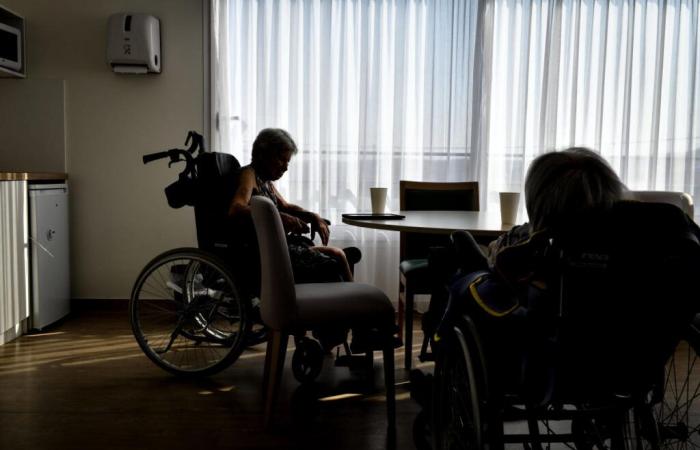More than two years after the publication of Victor Castanet’s shocking book, The Gravediggersreporting widespread acts of mistreatment in nursing homes, the Senate is sounding the alarm on the financial situation of retirement homes, particularly in the public sector, most of which are facing financial difficulties “of an unprecedented scale”. This situation raises the concern of elected officials in view of the many challenges posed in the medium term by the ageing of the French population. Currently, more than 600,000 residents are cared for in residential establishments for dependent elderly people. However, by 2050, the French dependent elderly population is expected to increase by 46%.
Over the past three years, “not only has the proportion of loss-making nursing homes increased, but the scale of the deficits has worsened, exposing many establishments to short-term cash flow difficulties,” indicates an information report made public this Wednesday, September 25 by the Senate Committee on Social Affairs. This 199-page document mentions “a combination of cyclical and structural causes […] that one-off aid will not be enough to overcome.” “The current situation is catastrophic,” says LR senator Chantal Deseyne, one of the three senators behind this report. “We are making a radical observation by saying that the sector is at the end of its tether and that it needs to be rebuilt.”
Among the options discussed by the Upper House to redress the situation: the elimination of a public holiday, following the model of what was already done in 2004 with Whit Monday, in order to increase the revenue of the National Solidarity Fund for Autonomy (CNSA).
800 million euros deficit for public nursing homes
According to figures from the Senate, the share of loss-making nursing homes increased from 27% to 66% between 2020 and 2023. In the public sector, 84.4% of establishments recorded a level of expenditure higher than their funding. The French Hospital Federation estimates the deficit for 2023 at 800 million euros. “While private, for-profit nursing homes have more room to adjust their revenue, they have also suffered a drop in their net profit rate, which has practically halved between 2017 and 2023,” the Upper House said.
The establishments were caught between the salary increases linked to the two Ségur de la Santé and the increase in the civil servants’ index point, the inflationary context of the last two years, which weighed on expenses linked to food and energy, and the “insufficient” evolution of the accommodation rate, lower than inflation. On this last aspect, the authors of the report propose an annual revaluation mechanism, indexed to the increase in prices, in order to “secure the resources of the Ehpad”.
Released at the end of 2023, the emergency fund for medico-social establishments and services in difficulty, with 100 million euros, 80% of which was directed to nursing homes, proved insufficient given the scale of the difficulties. “We regret the ad hoc and insufficient responses. The government preferred to increase the flow rate of a leaky tap rather than repair it,” castigates Chantal Deseyne.
However, the accounts of the autonomy branch should be clearly in surplus this year, with an additional 1.2 billion euros, a consequence of the allocation voted in 2020 to its coffers of a fraction of the generalized social contribution (CSG). This sum could be mobilized to avoid certain establishments the risk of cessation of payments. Nevertheless, the surplus should be cancelled from 2027 under the effect of the increase in expenditure, which calls for finding other financing levers.
“A crisis of confidence”
Another phenomenon facing nursing homes which directly impacts their accounts: a significant drop in the number of residents since 2020, which may seem paradoxical in view of the ageing of the population, but which is explained by a succession of crises.
The occupancy rate of nursing homes has fallen sharply, from 93% in the first quarter of 2020 to 87.20% in the second quarter of 2021. However, it had risen to 88.7% at the end of last year. The covid-19 pandemic explains this decline over a short period, a consequence of the significant number of deaths among the elderly during the pandemic, but also of the restrictive measures put in place by the establishments, which may have slowed down new admissions.
The report also highlights the influence that the Orpea scandal may have had, following the publication of Victor Castanet’s investigative book, Les Fossoyeurs, which was widely publicized. The senators thus speak of “a crisis of confidence”, following the journalist’s revelations about a generalized system of cost optimization, at the origin of many cases of mistreatment.
Let us recall that after this affair, the Senate launched its own commission of inquiry into the methods of control of nursing homes by the administration, reporting “serious inadequacies”.
An outdated financing system?
Currently, the financing of nursing homes is based on three pillars: accommodation, care and dependency support. The accommodation section is financed by the resident, its amount is determined by the level of service provided by the establishment, a bit like a hotel (meals, activities, cleaning, etc.) and can vary greatly from one nursing home to another, particularly in the private sector.
The dependency section is partly covered by the Departmental Council via a personalized autonomy allowance. It is calculated on the basis of the GIR point, a scale (from 1 to 6) which makes it possible to estimate the resident’s level of dependency. Finally, the care section is financed by the Regional Health Agency (ARS), with an allocation paid to each medico-social establishment.
To summarize: the resources of nursing homes are covered for 32% by the care section, for 14% by the dependency section and for 54% by the accommodation section. However, it is these last two sections which are mainly in deficit today.
The senators believe that the tariff equations used to determine the flat rates for the care and dependency sections present “major methodological biases”. They call for the implementation of a “global tariff” for care, already used in nearly a third of establishments. In addition to the care already covered by the partial tariff, the “global tariff” includes consultations with general practitioners, auxiliary care, and certain radiological and biological examinations. It would reduce the hospitalization rate of residents and therefore the expenditure for Health Insurance.
Expand the performance of the solidarity autonomy contribution
Another financing lever highlighted by this report: the creation of a second solidarity day. According to the calculations of the Upper House, this would make it possible to release 2.4 billion euros to replenish the National Solidarity Fund for Autonomy, partly financed by the CSG. It should be noted, however, that one of the three authors of this report, the environmentalist Anne Souyris, wanted to distance herself from this measure: “This second public holiday worked would amount to placing the entire burden of solidarity on low-income employees, excluding other forms of income, such as those from real estate assets,” she points out.
The first solidarity day, initially set for Whit Monday before being modified, was established by the law of June 30, 2004, after the heatwave of 2003. It is an unpaid working day, already intended to finance the care of elderly people who are losing their autonomy. Employers agree to pay the State a contribution equivalent to 0.3% of their annual payroll, which is called the solidarity autonomy contribution (CSA).
The Senate report also mentions the possibility of “generalized” dependency insurance, which could be attached to supplementary health insurance contracts. “Ultimately, an average contribution of around a dozen euros would provide nursing home residents with an income of 300 to 500 euros, which would offset their remaining costs,” explains Senator Chantal Deseyne.
Engage in architectural reflection
Geographic isolation of establishments, rooms that are too small, common areas that are too large and dehumanized… the report also questions infrastructures designed as places of care rather than places of life. “It is crucial to transform nursing homes into micro-city centers, with places to live (park, square, landscaped garden) and integrated services (France Services house, mini-market, café, hairdressing salon). The territorial network of nursing homes is an asset for revitalizing the regions,” the senators emphasize. “We have more nursing homes in France than post offices. We could use this land to reopen a certain number of services and reduce the territorial divide,” suggests RDPI senator Solanges Nadille, the third signatory of the report.
But these transformations must also take into consideration the challenges of the energy transition and the health risk posed by climate change, particularly with increasingly frequent and intense heatwaves. Today, only 4% of nursing homes have air-conditioned rooms.






